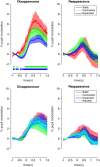Simulated forward and backward self motion, based on realistic parameters, causes motion induced blindness
- PMID: 28851914
- PMCID: PMC5574926
- DOI: 10.1038/s41598-017-09424-6
Simulated forward and backward self motion, based on realistic parameters, causes motion induced blindness
Abstract
Motion Induced Blindness (MIB) is a well-established visual phenomenon whereby highly salient targets disappear when viewed against a moving background mask. No research has yet explored whether contracting and expanding optic flow can also trigger target disappearance. We explored MIB using mask speeds corresponding to driving at 35, 50, 65 and 80 km/h in simulated forward (expansion) and backward (contraction) motion as well as 2-D radial movement, random, and static mask motion types. Participants (n = 18) viewed MIB targets against masks with different movement types, speed, and target locations. To understand the relationship between saccades, pupil response and perceptual disappearance, we ran two additional eye-tracking experiments (n = 19). Target disappearance increased significantly with faster mask speeds and upper visual field target presentation. Simulated optic flow and 2-D radial movement caused comparable disappearance, and all moving masks caused significantly more disappearance than a static mask. Saccades could not entirely account for differences between conditions, suggesting that self-motion optic flow does cause MIB in an artificial setting. Pupil analyses implied that MIB disappearance induced by optic flow is not subjectively salient, potentially explaining why MIB is not noticed during driving. Potential implications of MIB for driving safety and Head-Up-Display (HUD) technologies are discussed.
Conflict of interest statement
The authors declare that they have no competing interests.
Figures









Similar articles
-
Individual differences in motion-induced blindness: The effects of mask coherence and depth ordering.Vision Res. 2017 Dec;141:117-126. doi: 10.1016/j.visres.2016.11.008. Epub 2017 May 4. Vision Res. 2017. PMID: 28057581
-
Motion-aftereffect-induced blindness.J Vis. 2009 Oct 13;9(11):11.1-7. doi: 10.1167/9.11.11. J Vis. 2009. PMID: 20053074
-
The role of mask coherence in motion-induced blindness.Perception. 2011;40(12):1503-18. doi: 10.1068/p6976. Perception. 2011. PMID: 22474768
-
Motion-induced blindness and microsaccades: cause and effect.J Vis. 2010 Dec 20;10(14):22. doi: 10.1167/10.14.22. J Vis. 2010. PMID: 21172899 Free PMC article.
-
Motion-induced blindness and motion streak suppression.Curr Biol. 2009 Feb 24;19(4):325-9. doi: 10.1016/j.cub.2008.12.053. Epub 2009 Feb 12. Curr Biol. 2009. PMID: 19217295
Cited by
-
Attentional biases, as measured by motion-induced blindness, are linked to schizophrenia traits.PLoS One. 2025 Jun 24;20(6):e0325609. doi: 10.1371/journal.pone.0325609. eCollection 2025. PLoS One. 2025. PMID: 40554481 Free PMC article.
-
Motion-induced blindness shows spatial anisotropies in conscious perception.Sci Rep. 2024 Nov 12;14(1):27718. doi: 10.1038/s41598-024-78939-6. Sci Rep. 2024. PMID: 39532989 Free PMC article.
-
A multiple-response frequency-tagging paradigm measures graded changes in consciousness during perceptual filling-in.Neurosci Conscious. 2020 Apr 12;2020(1):niaa002. doi: 10.1093/nc/niaa002. eCollection 2020. Neurosci Conscious. 2020. PMID: 32296545 Free PMC article.
-
A compendium of considerations for methods in motion-induced blindness research.Behav Res Methods. 2025 Aug 13;57(9):259. doi: 10.3758/s13428-025-02789-x. Behav Res Methods. 2025. PMID: 40804191 Review.
References
-
- Bonneh, Y. S., Cooperman, a. & Sagi, D. Motion-induced blindness in normal observers. Nature411, 798–801 (2001). - PubMed
MeSH terms
LinkOut - more resources
Full Text Sources
Other Literature Sources
Miscellaneous

